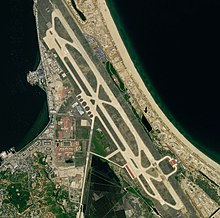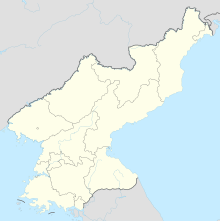Kalma Airport
Wonsan Airport | |||||||||||||||||||
|---|---|---|---|---|---|---|---|---|---|---|---|---|---|---|---|---|---|---|---|
 | |||||||||||||||||||
 | |||||||||||||||||||
| Summary | |||||||||||||||||||
| Airport type | Military/Public | ||||||||||||||||||
| Owner | North Korean government | ||||||||||||||||||
| Serves | Wonsan | ||||||||||||||||||
| Location | Wonsan, Kangwon-do, North Korea | ||||||||||||||||||
| Opened | September 24, 2015 (commercial flights) | ||||||||||||||||||
| Coordinates | 39°9′59″N 127°29′3″E / 39.16639°N 127.48417°ECoordinates: 39°9′59″N 127°29′3″E / 39.16639°N 127.48417°E | ||||||||||||||||||
| Map | |||||||||||||||||||
 WOS Location in North Korea | |||||||||||||||||||
| Runways | |||||||||||||||||||
| |||||||||||||||||||
| Kalma Airport | |
| Hangul | |
|---|---|
| Hanja | 葛麻飛行場 |
| Revised Romanization | Galma Bihaengjang |
| McCune–Reischauer | Kalma Bihaengjang |
Kalma Airport (IATA: WOS, ICAO: ZKWS) is a dual-use civil and military airport in Wonsan, Kangwon-do, North Korea. A new international terminal and passenger ramp opened in September 2015.[citation needed]

History[]
Korean War[]
The Republic of Korea Army Capital Division captured Wonsan Airfield on 10 October 1950.[1] On 13 October, Major General Field Harris, commander of the 1st Marine Air Wing, flew into the airfield, followed the next day by VMF-312 and other elements of Marine Aircraft Group 12.[2] The airfield was used by the United States Marine Corps and USAF under the designation K-25. By 12 October the USAF's Cargo Combat Command was flying supplies into the airfield.[1]
UN forces evacuated Wonsan in December 1950. The airfield was rendered unusable for the remainder of the war by the Blockade of Wonsan.
Modernisation[]
In July 2013, Kim Jong-un approved plans for a complete redesign of the airport, turning it into an international airport for civilian use. The new airport was designed by the Chinese architectural firm PLT Planning & Architecture. The redesign will include two 36,000-square-foot oval-shaped terminals, one serving domestic flights and one serving international flights, that will each contain six gates and several duty-free stores. The runways will also be extended to 3500 metres. It is expected to cost US$200 million.[3]
On 24 September 2015, the first commercial civilian flight landed at Wonsan Airport as a part of an aviation-related tour with thirty passengers.[citation needed] Photographs of the inaugural flight reveal a very much redesigned terminal building, doing away with the original dual-terminal circular layout. The new terminal has a single L-shaped building.
It is reported that the airport cost around $200 million to build, with most of the work being carried out by the military. In July 2015, the first major event, an aeronautics display and contest, took place at the airport.[4]
In September 2016 the Wonsan Air Festival took place for the first time, with the Korean People's Army Air Force and the North Korean airline Air Koryo displaying a number of their aircraft.[5][6][7] A second edition was planned for September 2017 but it was cancelled amidst international tensions.[8][9]
Asiana Airlines became the first foreign airline to operate to the newly reconstructed airport at Wonsan.[10] Air Koryo previously operated charter services from the original Wonsan Airport to South Korea prior to the end of the Sunshine policy.[citation needed]
In July 2018 a C-17 of the US Air Force's 204th Airlift Squadron collected 55 cases of human remains from Wonsan. It is thought that these are remains of US or other UN servicemen from the Korean War.[11] The C-17 then flew to Osan Air Base in South Korea.[12][13]
Infrastructure[]
Wonsan Airport has two runways. A new runway was constructed parallel to the existing main runway, which is 375 metres longer. The existing runway was converted into a taxiway.
A new terminal opened in 2015 to allow the airport to serve commercial passenger flights. The new construction features 2 jetbridges and a newly designed apron that can accommodate 12 commercial aircraft at any one time.
Airlines and destinations[]
| Airlines | Destinations |
|---|---|
| Air Koryo | Pyongyang |
References[]
- ^ Jump up to: a b Futrell, Robert Frank (1983). The United States Air Force in Korea, 1950–1953 (PDF). Washington, D.C.: Office of Air Force History, United States Air Force. p. 212. ISBN 9780912799711. OCLC 7555397.
 This article incorporates text from this source, which is in the public domain.
This article incorporates text from this source, which is in the public domain.
- ^ Smith, Charles (2007). U.S. Marines in the Korean War (PDF). Government Printing Office. p. 195. ISBN 9780160872518.
 This article incorporates text from this source, which is in the public domain.
This article incorporates text from this source, which is in the public domain.
- ^ Wong, Olga (29 July 2013). "Kim Jong-un gives nod to Hong Kong firm to redesign Pyongyang airport". South China Morning Post. Retrieved 29 July 2013.
- ^ Grisafi, John (30 July 2015). "Wonsan Airport nears completion, with potential for impact on tourism and economy". NK News. Archived from the original on 16 June 2019. Retrieved 15 January 2017.
- ^ North Korea is Hosting its First Air Show February 18, 2016 Popular Mechanics Retrieved February 3, 2017
- ^ North Korea's Wonsan Friendship Air Festival USA Today Retrieved February 3, 2017
- ^ North Korea shows off fighter jets at its first international air show September 26, 2016 International Business Times Retrieved February 3, 2017
- ^ North Korea cancels 2017 Wonsan Air Show August 25, 2017 NHK Retrieved September 7, 2017
- ^ North Korea scraps Wonsan Air Show as sanctions tighten August 28, 2017 South China Morning Post Retrieved September 8, 2017
- ^ Driessche, Maarten Van Den (February 1, 2018). "First intra Korea flight by Asiana Airlines Airbus A321, Wonsan to Yongyang". Aviation24.be.
- ^ "War Remains Could Also Be Of French, Australian Soldiers: Jim Mattis". NDTV. July 27, 2018. Retrieved July 28, 2018.
- ^ Fichtl, Marcus (July 26, 2018). "N. Korea hands over 55 cases of remains thought to be US war dead". Stars and Stripes. Retrieved July 27, 2018.
- ^ Maresca, Thomas (July 26, 2018). "North Korea hands over remains said to be US soldiers from Korean War, White House says". USA Today. Retrieved July 27, 2018.
![]() This article incorporates public domain material from the United States Air Force website https://www.af.mil.
This article incorporates public domain material from the United States Air Force website https://www.af.mil.
- Airports in North Korea
- Korean War air bases
